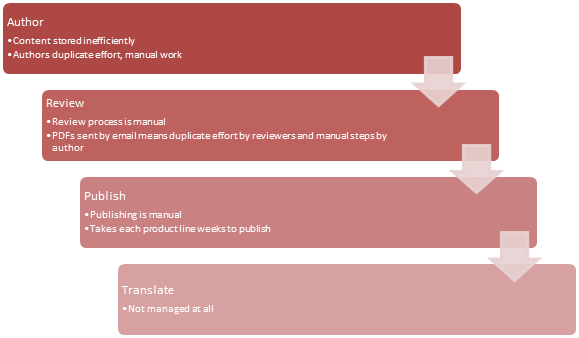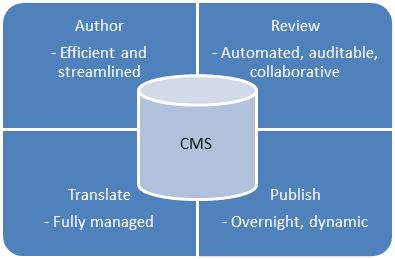 If management hasn’t come looking for answers about how to effectively manage all the content floating around your organization in social media, documents, emails and information in various electronic file cabinets, it’s probably just a matter of time. The best thing you can do now is start preparing a content management systems business case.
If management hasn’t come looking for answers about how to effectively manage all the content floating around your organization in social media, documents, emails and information in various electronic file cabinets, it’s probably just a matter of time. The best thing you can do now is start preparing a content management systems business case.
In this article, we make a lot of references to content management systems, but we really mean component content management systems. And yes, there is a difference between a content management system and a component content management system. Content Management System is a generic term for many different types of content management systems, but out of all of those systems only a component content system will really do the job of organizing your content and hitting the nirvana of content: create once – publish everywhere.
Why do you want a componentized CMS? Think of all your content as little Lego ® like bricks (or components) that can be assembled in any combination you like if all of the information is organized and stored correctly. As an example, let’s consider the description of your company as a component (little brick). How many places is your company’s About Us description located? If you’re like us, it’s probably in around 100 or more locations on website(s), printed materials and even advertising media. What if you wanted to change this description? In a properly configured component content management system, you’d be able to change it one place and all of the places it was published would be updated (or at least you’d get a to-do list).
For now and the future (raise your hand and swear—this is important), when you hear content management systems or CMS, think component, then CMS (CCMS). It’s okay to keep this to yourself since carnal knowledge like this is a) really important b) something that sometimes keeps us from hanging out with the cool kids in the back of the bus c) has often been prescribed as a sleep aid in C-Level meetings.
However, our little demonstration of the About Your Company should have started pinging a lot of ideas for your business case since creating once and publishing everywhere will certainly save you time; and since time is money … cost savings. Also, having the content in one place will reduce the amount of publishing errors so your content quality will improve. And better quality content means a better reputation, which positions you for long-term brand success.
Business cases are nothing more than documenting why the world will be better (increased revenue or decreased expenses) by doing something new. So, in the case of a CCMS you’ll be able to easily show both.
In a nutshell, with your business case, you are striving to convey one key piece of information: It makes great business sense to value your information assets and manage it effectively and to do that your organization needs a CCMS. The key is to convince management that valuing those assets will save time and money.
To build a great content management system business case you need to follow 8 steps:
- Conduct a content audit. Get to know how and what your company creates on a daily, weekly and yearly basis. Don’t stop at just your tech docs but venture into every department to see what is created and how often it’s updated.
- Estimate your possible re-use. This means knowing (or quickly finding out) what content can be used in multiple product guides, what multi-channel publishing you can create, what content could be re-used by other departments such as training and marketing.
- Identify the increased flexibility you will enjoy. What impossibilities become possible? This could be anything from tracking review comments, to fool-proof versioning, to tracking translated and primary language topics, to publishing overnight.
- Calculate your ROI. Calculate your return on investment (ROI). ROI is simply the amount you expect to save by making the change. You can use our ROI calculator tool to calculate every cost savings and every benefit you can think of. The more robust, the better.
- Show potential metrics, both before and after. You’ll need to prove that the content is being managed inefficiently now and that you’re saving time after implementation is complete.
- Acknowledge your current limitations. Illustrate where you are inefficient and limited now and then identify what main areas you will improve on. Give management the big picture.
- Propose a phased approach including a pilot or proof of concept. Don’t make the company jump into the deep end until you can prove that you can swim.
- Look for wins and losses. In your audit, did you find some great content or horrible failures at your company or your competitors? Write these down and find great visuals for them. Nothing quiets a room like seeing your expensive new brochure with a high-margin product’s name spelled incorrectly.
Once you are armed with information, focus on creating the presentations and discussing the benefits of the new component content management system with key decision makers in non-meeting meetings. Great presentations tell a great story in the most effective way possible. This almost always means having lots of visuals and few details on screen. If you can show what you mean, then do so, and avoid the detailed bullet points.

Content Lifecycle Currently: Inefficient and Manual
Stay high level and don’t get bogged down into details. Yes, you need to know the numbers you’ve researched and be able to back them up with solid reasoning, but put your focus on including the theory behind good information management of your organization’s content. Visuals that capture your current content lifecycle and the ideal future state can be more compelling than a bulleted list of KPIs. Consider how the following two graphics help build your content management system business case, by depicting current state and desired future state:
You’ll almost always need to accompany your presentation with a more formal business case proposal. This should be your handout and should contain your detailed calculations and metrics. It can be referenced in the presentation. This way you’ll provide the hard numbers and arguments you’ll need for the finance folks, but not bore your main decision makers to tears. However, you may want to take a few of your more important charts (top-line ROI for instance) and create an appendix to your presentation. Don’t include the appendix in your presentation but keep those slides at the back of the slide deck. Some “glad you asked” slides are the mark of a prepared presenter.

Integrated Content Lifecycle, with CMS as “Brain”
While the presentations are really important, you also must also pay attention to the social side of business decision-making. To ensure that your business case gets the attention it deserves, make it a point to have discussions with key decision-makers throughout the organization to first learn their thoughts on changing how your company manages its content, and later to get their feedback on your big idea.
The closed door meetings will provide a good opportunity for you to get feedback and tailor the business case as you near the all-important presentation.
Regardless if it’s the presentation or the equally important back channel networking, it’s crucial to take your time and do your homework in building the content management system business case. Like any other company asset, your information assets can either be managed poorly or managed well. A great business case for a content management system will help your company manage its information assets wisely.
Other Resources for the Content Management Systems Business Case:
General: (Component) Content Management Systems
Jacquie Samuels, TechWhirl: ROI Calculator Tool
Jack Molisani, LavaCon 2012: Building a Business Case
Chantel Brathwaite, Techwhirl: Digital Asset Management and the Single Tech Writer